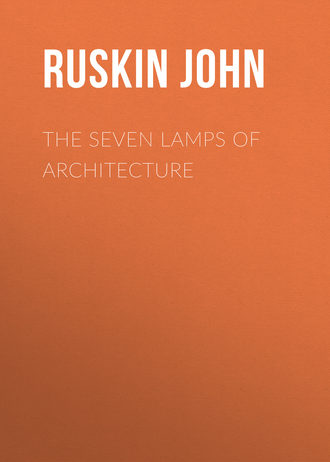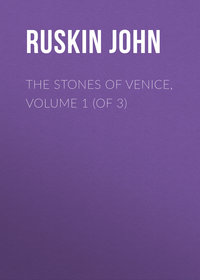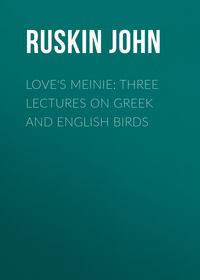 полная версия
полная версияThe Seven Lamps of Architecture
XVIII. It is well known, that what is meant by a church's being built of marble is, in nearly all cases, only that a veneering of marble has been fastened on the rough brick wall, built with certain projections to receive it; and that what appear to be massy stones, are nothing more than external slabs.
Now, it is evident, that, in this case, the question of right is on the same ground as in that of gilding. If it be clearly understood that a marble facing does not pretend or imply a marble wall, there is no harm in it; and as it is also evident that, when very precious stones are used, as jaspers and serpentines, it must become, not only an extravagant and vain increase of expense, but sometimes an actual impossibility, to obtain mass of them enough to build with, there is no resource but this of veneering; nor is there anything to be alleged against it on the head of durability, such work having been by experience found to last as long, and in as perfect condition, as any kind of masonry. It is, therefore, to be considered as simply an art of mosaic on a large scale, the ground being of brick, or any other material; and when lovely stones are to be obtained, it is a manner which should be thoroughly understood, and often practised. Nevertheless, as we esteem the shaft of a column more highly for its being of a single block, and as we do not regret the loss of substance and value which there is in things of solid gold, silver, agate, or ivory; so I think the walls themselves may be regarded with a more just complacency if they are known to be all of noble substance; and that rightly weighing the demands of the two principles of which we have hitherto spoken—Sacrifice and Truth, we should sometimes rather spare external ornament than diminish the unseen value and consistency of what we do; and I believe that a better manner of design, and a more careful and studious, if less abundant decoration would follow, upon the consciousness of thoroughness in the substance. And, indeed, this is to be remembered, with respect to all the points we have examined; that while we have traced the limits of license, we have not fixed those of that high rectitude which refuses license. It is thus true that there is no falsity, and much beauty in the use of external color, and that it is lawful to paint either pictures or patterns on whatever surfaces may seem to need enrichment. But it is not less true, that such practices are essentially unarchitectural; and while we cannot say that there is actual danger in an over use of them, seeing that they have been always used most lavishly in the times of most noble art, yet they divide the work into two parts and kinds, one of less durability than the other, which dies away from it in process of ages, and leaves it, unless it have noble qualities of its own, naked and bare. That enduring noblesse I should, therefore, call truly architectural; and it is not until this has been secured that the accessory power of painting may be called in, for the delight of the immediate time; nor this, as I think, until every resource of a more stable kind has been exhausted. The true colors of architecture are those of natural stone, and I would fain see these taken advantage of to the full. Every variety of hue, from pale yellow to purple, passing through orange, red, and brown, is entirely at our command; nearly every kind of green and gray is also attainable: and with these, and pure white, what harmonies might we not achieve? Of stained and variegated stone, the quantity is unlimited, the kinds innumerable; where brighter colors are required, let glass, and gold protected by glass, be used in mosaic—a kind of work as durable as the solid stone, and incapable of losing its lustre by time—and let the painter's work be reserved for the shadowed loggia and inner chamber. This is the true and faithful way of building; where this cannot be, the device of external coloring may, indeed, be employed without dishonor; but it must be with the warning reflection, that a time will come when such aids must pass away, and when the building will be judged in its lifelessness, dying the death of the dolphin. Better the less bright, more enduring fabric. The transparent alabasters of San Miniato, and the mosaics of St. Mark's, are more warmly filled, and more brightly touched, by every return of morning and evening rays; while the hues of our cathedrals have died like the iris out of the cloud; and the temples whose azure and purple once flamed above the Grecian promontories, stand in their faded whiteness, like snows which the sunset has left cold.

PLATE II.—(Page 55—Vol. V.)
Part of the Cathedral of St. Lo, Normandy.
XIX. The last form of fallacy which it will be remembered we had to deprecate, was the substitution of cast or machine work for that of the hand, generally expressible as Operative Deceit.
There are two reasons, both weighty, against this practice; one, that all cast and machine work is bad, as work; the other, that it is dishonest. Of its badness, I shall speak in another place, that being evidently no efficient reason against its use when other cannot be had. Its dishonesty, however, which, to my mind, is of the grossest kind, is, I think, a sufficient reason to determine absolute and unconditional rejection of it.
Ornament, as I have often before observed, has two entirely distinct sources of agreeableness: one, that of the abstract beauty of its forms, which, for the present, we will suppose to be the same whether they come from the hand or the machine; the other, the sense of human labor and care spent upon it. How great this latter influence we may perhaps judge, by considering that there is not a cluster of weeds growing in any cranny of ruin which has not a beauty in all respects nearly equal, and, in some, immeasurably superior, to that of the most elaborate sculpture of its stones: and that all our interest in the carved work, our sense of its richness, though it is tenfold less rich than the knots of grass beside it; of its delicacy, though it is a thousand fold less delicate; of its admirableness, though a millionfold less admirable; results from our consciousness of its being the work of poor, clumsy, toilsome man. Its true delightfulness depends on our discovering in it the record of thoughts, and intents, and trials, and heart-breakings—of recoveries and joyfulnesses of success: all this can be traced by a practised eye; but, granting it even obscure, it is presumed or understood; and in that is the worth of the thing, just as much as the worth of anything else we call precious. The worth of a diamond is simply the understanding of the time it must take to look for it before it can be cut. It has an intrinsic value besides, which the diamond has not (for a diamond has no more real beauty than a piece of glass); but I do not speak of that at present; I place the two on the same ground; and I suppose that hand-wrought ornament can no more be generally known from machine work, than a diamond can be known from paste; nay, that the latter may deceive, for a moment, the mason's, as the other the jeweller's eye; and that it can be detected only by the closest examination. Yet exactly as a woman of feeling would not wear false jewels, so would a builder of honor disdain false ornaments. The using of them is just as downright and inexcusable a lie. You use that which pretends to a worth which it has not; which pretends to have cost, and to be, what it did not, and is not; it is an imposition, a vulgarity, an impertinence, and a sin. Down with it to the ground, grind it to powder, leave its ragged place upon the wall, rather; you have not paid for it, you have no business with it, you do not want it. Nobody wants ornaments in this world, but everybody wants integrity. All the fair devices that ever were fancied, are not worth a lie. Leave your walls as bare as a planed board, or build them of baked mud and chopped straw, if need be; but do not rough-cast them with falsehood.
This, then, being our general law, and I hold it for a more imperative one than any other I have asserted; and this kind of dishonesty the meanest, as the least necessary; for ornament is an extravagant and inessential thing; and, therefore, if fallacious, utterly base—this, I say, being our general law, there are, nevertheless, certain exceptions respecting particular substances and their uses.
XX. Thus in the use of brick; since that is known to be originally moulded, there is no reason why it should not be moulded into diverse forms. It will never be supposed to have been cut, and therefore, will cause no deception; it will have only the credit it deserves. In flat countries, far from any quarry of stone, cast brick may be legitimately, and most successfully, used in decoration, and that elaborate, and even refined. The brick mouldings of the Palazzo Pepoli at Bologna, and those which run round the market-place of Vercelli, are among the richest in Italy. So also, tile and porcelain work, of which the former is grotesquely, but successfully, employed in the domestic architecture of France, colored tiles being inserted in the diamond spaces between the crossing timbers; and the latter admirably in Tuscany, in external bas-reliefs, by the Robbia family, in which works, while we cannot but sometimes regret the useless and ill-arranged colors, we would by no means blame the employment of a material which, whatever its defects, excels every other in permanence, and, perhaps, requires even greater skill in its management than marble. For it is not the material, but the absence of the human labor, which makes the thing worthless; and a piece of terra cotta, or of plaster of Paris, which has been wrought by human hand, is worth all the stone in Carrara, cut by machinery. It is, indeed, possible, and even usual, for men to sink into machines themselves, so that even hand-work has all the characters of mechanism; of the difference between living and dead hand-work I shall speak presently; all that I ask at present is, what it is always in our power to secure—the confession of what we have done, and what we have given; so that when we use stone at all, since all stone is naturally supposed to be carved by hand, we must not carve it by machinery; neither must we use any artificial stone cast into shape, nor any stucco ornaments of the color of stone, or which might in anywise be mistaken for it, as the stucco mouldings in the cortile of the Palazzo Vecchio at Florence, which cast a shame and suspicion over every part of the building. But for ductile and fusible materials, as clay, iron, and bronze, since these will usually be supposed to have been cast or stamped, it is at our pleasure to employ them as we will; remembering that they become precious, or otherwise, just in proportion to the hand-work upon them, or to the clearness of their reception of the hand-work of their mould.
But I believe no cause to have been more active in the degradation of our natural feeling for beauty, than the constant use of cast iron ornaments. The common iron work of the middle ages was as simple as it was effective, composed of leafage cut flat out of sheet iron, and twisted at the workman's will. No ornaments, on the contrary, are so cold, clumsy, and vulgar, so essentially incapable of a fine line, or shadow, as those of cast iron; and while, on the score of truth, we can hardly allege anything against them, since they are always distinguishable, at a glance, from wrought and hammered work, and stand only for what they are, yet I feel very strongly that there is no hope of the progress of the arts of any nation which indulges in these vulgar and cheap substitutes for real decoration. Their inefficiency and paltriness I shall endeavor to show more conclusively in another place, enforcing only, at present, the general conclusion that, if even honest or allowable, they are things in which we can never take just pride or pleasure, and must never be employed in any place wherein they might either themselves obtain the credit of being other and better than they are, or be associated with the downright work to which it would be a disgrace to be found in their company.
Such are, I believe, the three principal kinds of fallacy by which architecture is liable to be corrupted; there are, however, other and more subtle forms of it, against which it is less easy to guard by definite law, than by the watchfulness of a manly and unaffected spirit. For, as it has been above noticed, there are certain kinds of deception which extend to impressions and ideas only; of which some are, indeed, of a noble use, as that above referred to, the arborescent look of lofty Gothic aisles; but of which the most part have so much of legerdemain and trickery about them, that they will lower any style in which they considerably prevail; and they are likely to prevail when once they are admitted, being apt to catch the fancy alike of uninventive architects and feelingless spectators; just as mean and shallow minds are, in other matters, delighted with the sense of over-reaching, or tickled with the conceit of detecting the intention to over-reach; and when subtleties of this kind are accompanied by the display of such dextrous stone-cutting, or architectural sleight of hand, as may become, even by itself, a subject of admiration, it is a great chance if the pursuit of them do not gradually draw us away from all regard and care for the nobler character of the art, and end in its total paralysis or extinction. And against this there is no guarding, but by stern disdain of all display of dexterity and ingenious device, and by putting the whole force of our fancy into the arrangement of masses and forms, caring no more how these masses and forms are wrought out, than a great painter cares which way his pencil strikes. It would be easy to give many instances of the danger of these tricks and vanities; but I shall confine myself to the examination of one which has, as I think, been the cause of the fall of Gothic architecture throughout Europe. I mean the system of intersectional mouldings, which, on account of its great importance, and for the sake of the general reader, I may, perhaps, be pardoned for explaining elementarily.
XXI. I must, in the first place, however, refer to Professor Willis's account of the origin of tracery, given in the sixth chapter of his Architecture of the Middle Ages; since the publication of which I have been not a little amazed to hear of any attempts made to resuscitate the inexcusably absurd theory of its derivation from imitated vegetable form—inexcusably, I say, because the smallest acquaintance with early Gothic architecture would have informed the supporters of that theory of the simple fact, that, exactly in proportion to the antiquity of the work, the imitation of such organic forms is less, and in the earliest examples does not exist at all. There cannot be the shadow of a question, in the mind of a person familiarised with any single series of consecutive examples, that tracery arose from the gradual enlargement of the penetrations of the shield of stone which, usually supported by a central pillar, occupied the head of early windows. Professor Willis, perhaps, confines his observations somewhat too absolutely to the double sub-arch. I have given, in Plate VII. fig. 2, an interesting case of rude penetration of a high and simply trefoiled shield, from the church of the Eremitani at Padua. But the more frequent and typical form is that of the double sub-arch, decorated with various piercings of the space between it and the superior arch; with a simple trefoil under a round arch, in the Abbaye aux Hommes, Caen9 (Plate III. fig. 1); with a very beautifully proportioned quatrefoil, in the triforium of Eu, and that of the choir of Lisieux; with quatrefoils, sixfoils, and septfoils, in the transept towers of Rouen (Plate III. fig. 2); with a trefoil awkwardly, and very small quatrefoil above, at Coutances, (Plate III. fig. 3); then, with multiplications of the same figures, pointed or round, giving very clumsy shapes of the intermediate stone (fig. 4, from one of the nave chapels of Rouen, fig. 5, from one of the nave chapels of Bayeaux), and finally, by thinning out the stony ribs, reaching conditions like that of the glorious typical form of the clerestory of the apse of Beauvais (fig. 6).

PLATE III.—(Page 60—Vol. V.)
Traceries From Caen, Bayeux, Rouen, and Beavais.
XXII. Now, it will be noticed that, during the whole of this process, the attention is kept fixed on the forms of the penetrations, that is to say, of the lights as seen from the interior, not of the intermediate stone. All the grace of the window is in the outline of its light; and I have drawn all these traceries as seen from within, in order to show the effect of the light thus treated, at first in far off and separate stars, and then gradually enlarging, approaching, until they come and stand over us, as it were, filling the whole space with their effulgence. And it is in this pause of the star, that we have the great, pure, and perfect form of French Gothic; it was at the instant when the rudeness of the intermediate space had been finally conquered, when the light had expanded to its fullest, and yet had not lost its radiant unity, principality, and visible first causing of the whole, that we have the most exquisite feeling and most faultless judgments in the management alike of the tracery and decorations. I have given, in Plate X., an exquisite example of it, from a panel decoration of the buttresses of the north door of Rouen; and in order that the reader may understand what truly fine Gothic work is, and how nobly it unites fantasy and law, as well as for our immediate purpose, it will be well that he should examine its sections and mouldings in detail (they are described in the fourth Chapter, § xxvii.), and that the more carefully, because this design belongs to a period in which the most important change took place in the spirit of Gothic architecture, which, perhaps, ever resulted from the natural progress of any art. That tracery marks a pause between the laying aside of one great ruling principle, and the taking up of another; a pause as marked, as clear, as conspicuous to the distant view of after times, as to the distant glance of the traveller is the culminating ridge of the mountain chain over which he has passed. It was the great watershed of Gothic art. Before it, all had been ascent; after it, all was decline; both, indeed, by winding paths and varied slopes; both interrupted, like the gradual rise and fall of the passes of the Alps, by great mountain outliers, isolated or branching from the central chain, and by retrograde or parallel directions of the valleys of access. But the track of the human mind is traceable up to that glorious ridge, in a continuous line, and thence downwards. Like a silver zone—
"Flung about carelessly, it shines afar,Catching the eye in many a broken link,In many a turn and traverse, as it glides.And oft above, and oft below, appears—* * * * to him who journeys upAs though it were another."And at that point, and that instant, reaching the place that was nearest heaven, the builders looked back, for the last time, to the way by which they had come, and the scenes through which their early course had passed. They turned away from them and their morning light, and descended towards a new horizon, for a time in the warmth of western sun, but plunging with every forward step into more cold and melancholy shade.
XXIII. The change of which I speak, is inexpressible in few words, but one more important, more radically influential, could not be. It was the substitution of the line for the mass, as the element of decoration.
We have seen the mode in which the openings or penetration of the window expanded, until what were, at first, awkward forms of intermediate stone, became delicate lines of tracery: and I have been careful in pointing out the peculiar attention bestowed on the proportion and decoration of the mouldings of the window at Rouen, in Plate X., as compared with earlier mouldings, because that beauty and care are singularly significant. They mark that the traceries had caught the eye of the architect. Up to that time, up to the very last instant in which the reduction and thinning of the intervening stone was consummated, his eye had been on the openings only, on the stars of light. He did not care about the stone, a rude border of moulding was all he needed, it was the penetrating shape which he was watching. But when that shape had received its last possible expansion, and when the stone-work became an arrangement of graceful and parallel lines, that arrangement, like some form in a picture, unseen and accidentally developed, struck suddenly, inevitably, on the sight. It had literally not been seen before. It flashed out in an instant as an independent form. It became a feature of the work. The architect took it under his care, thought over it, and distributed its members as we see.
Now, the great pause was at the moment when the space and the dividing stone-work were both equally considered. It did not last fifty years. The forms of the tracery were seized with a childish delight in the novel source of beauty; and the intervening space was cast aside, as an element of decoration, for ever. I have confined myself, in following this change, to the window, as the feature in which it is clearest. But the transition is the same in every member of architecture; and its importance can hardly be understood, unless we take the pains to trace it in the universality, of which illustrations, irrelevant to our present purpose, will be found in the third Chapter. I pursue here the question of truth, relating to the treatment of the mouldings.
XXIV. The reader will observe that, up to the last expansion of the penetrations, the stone-work was necessarily considered, as it actually is, stiff, and unyielding. It was so, also, during the pause of which I have spoken, when the forms of the tracery were still severe and pure; delicate indeed, but perfectly firm.
At the close of the period of pause, the first sign of serious change was like a low breeze, passing through the emaciated tracery, and making it tremble. It began to undulate like the threads of a cobweb lifted by the wind. It lost its essence as a structure of stone. Reduced to the slenderness of threads, it began to be considered as possessing also their flexibility. The architect was pleased with this his new fancy, and set himself to carry it out; and in a little time, the bars of tracery were caused to appear to the eye as if they had been woven together like a net. This was a change which sacrificed a great principle of truth; it sacrificed the expression of the qualities of the material; and, however delightful its results in their first developments, it was ultimately ruinous.
For, observe the difference between the supposition of ductility, and that of elastic structure noticed above in the resemblance to tree form. That resemblance was not sought, but necessary; it resulted from the natural conditions of strength in the pier or trunk, and slenderness in the ribs or branches, while many of the other suggested conditions of resemblance were perfectly true. A tree branch, though in a certain sense flexible, is not ductile; it is as firm in its own form as the rib of stone; both of them will yield up to certain limits, both of them breaking when those limits are exceeded; while the tree trunk will bend no more than the stone pillar. But when the tracery is assumed to be as yielding as a silken cord; when the whole fragility, elasticity, and weight of the material are to the eye, if not in terms, denied; when all the art of the architect is applied to disprove the first conditions of his working, and the first attributes of his materials; this is a deliberate treachery, only redeemed from the charge of direct falsehood by the visibility of the stone surface, and degrading all the traceries it affects exactly in the degree of its presence.
XXV. But the declining and morbid taste of the later architects, was not satisfied with thus much deception. They were delighted with the subtle charm they had created, and thought only of increasing its power. The next step was to consider and represent the tracery, as not only ductile, but penetrable; and when two mouldings met each other, to manage their intersection, so that one should appear to pass through the other, retaining its independence; or when two ran parallel to each other, to represent the one as partly contained within the other, and partly apparent above it. This form of falsity was that which crushed the art. The flexible traceries were often beautiful, though they were ignoble; but the penetrated traceries, rendered, as they finally were, merely the means of exhibiting the dexterity of the stone-cutter, annihilated both the beauty and dignity of the Gothic types. A system so momentous in its consequences deserves some detailed examination.











